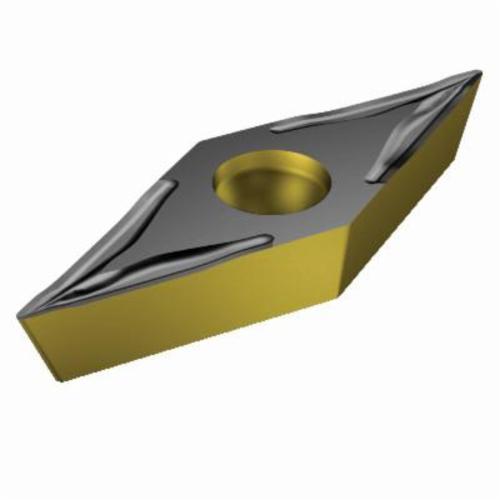Sandvik Coromant 5755925 CoroTurn® 107 Basic Shape Positive Turning Insert, VCGT 220-UM 1515, V-35 deg Diamond, 1515
VCGT Turning Inserts
1249064
MFG #: 5755925
Sandvik Coromant
29.85000
/ ea
- Alternate Catalog Number: VCGT 11 03 02-UM 1515
- ANSI Code: VCGT 220-UM 1515
- Catalog Number: 5755925
- Corner Radius: 0.0078 in
- Country of Origin: SE
- Finish: MTCVD Coated
- Gross Weight Per Pack: 1 lb
- Hand of Insert: Neutral
- Hole Diameter: 0.1102 in
- Included Angle: 35 deg
- ISO Code: VCGT 11 03 02-UM 1515
- Item Group: 130
- Length: 0.4358 in
- Relief Angle: 7 deg
- Series: CoroTurn® 107
- Thickness: 1/8 in
- Type: Basic Shape Positive
- UPC 11: 69826244686
- Width: UM
- Stock Status: NONSTOCK
- Brand: Sandvik Coromant
- Manufacturer: Sandvik Coromant
- Chipbreaker: UM
- Inscribed Circle: 1/4 in
- Insert Size: V - 35 deg Diamond
- Insert Style: VCGT
- Manufacturer's Grade: 1515
- Material: CARBIDE
- Material Grade: M/P
- Maximum Depth of Cut: 1.5 mm
- Shape: V-35 deg Diamond
Sandvik Coromant Turning Insert, Basic Shape Positive, Series: CoroTurn® 107, VCGT Insert, V-35 deg Diamond, 1.5 mm Maximum Depth of Cut, 1/4 in Inscribed Circle, 1/8 in Thickness, 0.4358 in Length, UM Chipbreaker, 0.0078 in Corner Radius, 0.1102 in Hole Dia, Manufacturer's Grade: 1515, ANSI Code: VCGT 220-UM 1515, ISO Code: VCGT 11 03 02-UM 1515, 35 deg Included Angle, 7 deg Relief Angle, Neutral Hand, Carbide, MTCVD Coated, Material Grade: M/P
- Features
| 40 - 60 deg countersunk hole and non-flat surface clamping interface |
| 1-side cutting |
| +/-0.13 mm THK and +/-0.025 mm inscribed circle tolerance |
| Sharp cutting edge |
| Solid carbide is extremely heat-resistant and used for high speed applications on cast iron, non-ferrous materials, plastics and other tough-to-machine materials |
| For external machining of small, long, slender components and internal machining |
| The positive insert shape combines low cutting forces with good edge strength |
| The screw clamping ensures stability and unobstructed chip flow |
| 0.1 - 0.16 mm/r cutting feed |
| 20 life cycle state |

